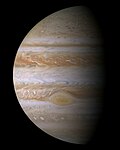Europa Clipper
 An Artist's view of the spacecraft | |
| Names | Europa Multiple Flyby Mission |
|---|---|
| Mission type | Planetary science |
| Operator | NASA |
| COSPAR ID | 2024-182A |
| SATCAT no. | 61507 |
| Spacecraft properties | |
| Launch mass | 6,065 kg (13,371 lb), including 2,750 kg (6,060 lb) fuel |
| Start of mission | |
| Launch date | October 14, 2024, 16:06:00 UTC |
| Rocket | Falcon Heavy Block 5 |
| Launch site | Kennedy/LC-39A |
| Contractor | SpaceX |
Europa Clipper (used to be called the Europa Multiple Flyby Mission) is a space probe made by NASA that will explore Europa. It is powered by solar panels, like NASA's Juno and European Space Agency's JUICE.
The spacecraft launched on October 14, 2024.[1] It did a flyby to Mars on March 1, 2025 using a Martian gravity assist. The spacecraft will reach Jupiter's moon Europa in April 2030 after two gravity assists and six years of travel.
Due to the radiation from the magnetosphere of Jupiter, the spacecraft would be into an elliptical orbit and make a lot of flybys of the moon Europa.
Main goals
[change | change source]The main goals of the Europa Clipper are to explore Europa, find life in the moon and select a perfect landing site for the Europa Lander. This exploration is about studying the three main requirements for life: water, energy, and chemistry.
Instruments onboard Europa Clipper
[change | change source]E-THEMIS, an infared camera system
MISE, another camera, "near infared" to find the building blocks of life
EIS, Europa Imaging System- An optical camera system
Europa-UVS- An ultraviolet spectrograph for the Europa Clipper
REASON, Radar for Europa Assesment and Sounding: Ocean to Near-Surface
ECM, a magnetometer for the Europa Clipper
PIMS- Plasma Instrument for Magnetic Sounding
MASPEX- Mass Spectrometer for Planetary Exploration
SUDA- Surface Dust Analyzer
Gravity & Radio Science
Journey
[change | change source]Europa Clipper will spend six years crusing to Jupiter, during which it will complete fly-bys of Mars and Earth. It will reach Jupiter in April 2030. The spacecraft will spend many months orbiting Jupiter, completing fly-bys of Europa to find life.
Details
[change | change source]| Launch | Launch Complex 39-A |
|---|---|
| Lifetime (in Jupiter's orbit) | 4 years |
| Rocket | Falcon Heavy |
| Launch date | October 14, 2024 |
| Launch time | 12:06 p.m EDT |
Related pages
[change | change source]- Jupiter Icy Moons Explorer, a probe sent by the European Space Agency
Refrences
[change | change source]- ↑ "NASA's Europa Clipper launches aboard SpaceX rocket, bound for Jupiter's icy ocean moon". Los Angeles Times. October 14, 2024. Retrieved October 14, 2024.





